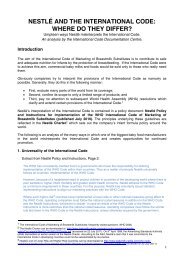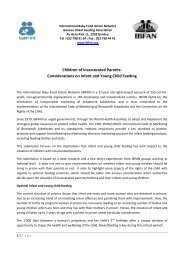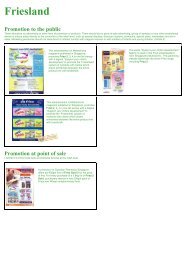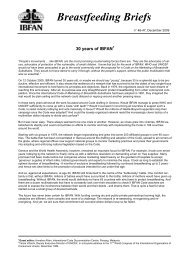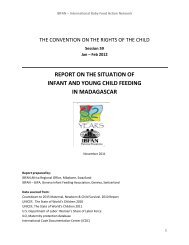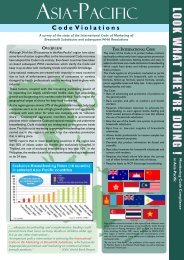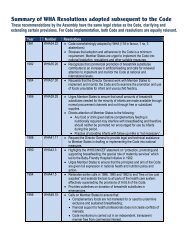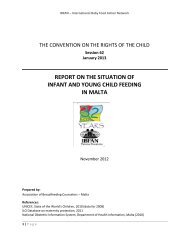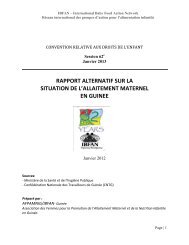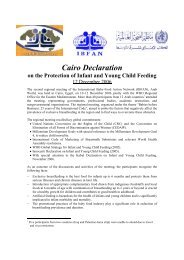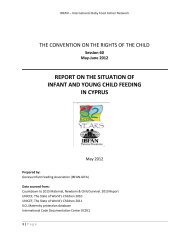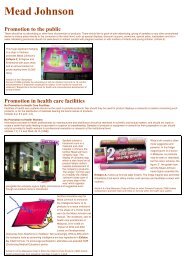Infant and young child feeding in emergencies. Making it ... - IBFAN
Infant and young child feeding in emergencies. Making it ... - IBFAN
Infant and young child feeding in emergencies. Making it ... - IBFAN
Create successful ePaper yourself
Turn your PDF publications into a flip-book with our unique Google optimized e-Paper software.
Day 2<br />
Utami, Chairman of the Sentra Laktasi (Breast<strong>feed<strong>in</strong>g</strong><br />
Centre) Indonesia, described the cascade breast<strong>feed<strong>in</strong>g</strong><br />
support used as part of the post 2006 Yogjakarta<br />
earthquake response <strong>in</strong> two districts of Indonesia.<br />
Through a system of facil<strong>it</strong>ator-counsellor-motivator, the<br />
programme has already succeeded <strong>in</strong> reach<strong>in</strong>g large<br />
number of mothers at family level, quickly. Follow-up<br />
found that 63% of mothers targeted <strong>in</strong> the programme<br />
were exclusively breast<strong>feed<strong>in</strong>g</strong>, regardless of hav<strong>in</strong>g<br />
received donations of <strong>in</strong>fant formula. In<strong>it</strong>ial costs of<br />
tra<strong>in</strong><strong>in</strong>g <strong>and</strong> materials development were covered by<br />
UNICEF. However the motivators, <strong>in</strong> particular, were<br />
empowered <strong>and</strong> cont<strong>in</strong>ued assist<strong>in</strong>g breast<strong>feed<strong>in</strong>g</strong><br />
mothers w<strong>it</strong>hout remuneration. In the discussion, <strong>it</strong> was<br />
clarified by the presenter – <strong>and</strong> other experiences from<br />
Pakistan <strong>emergencies</strong> – that such a response could not be<br />
mounted immediately, but could be set up w<strong>it</strong>h<strong>in</strong> 6 – 10<br />
weeks after the onset of an acute emergency.<br />
The follow<strong>in</strong>g presentation gave the perspective of<br />
Vicky Sibson, HQ Nutr<strong>it</strong>ion Advisor, SC UK, on<br />
complementary <strong>feed<strong>in</strong>g</strong> <strong>in</strong> <strong>emergencies</strong> (CFE). She<br />
detailed how SC UK, as one of the supporters 14 of the<br />
Operational Guidance on IFE, is work<strong>in</strong>g to implement<br />
<strong>and</strong> build on <strong>it</strong>s provisions w<strong>it</strong>h regard to complementary<br />
<strong>feed<strong>in</strong>g</strong>. This <strong>in</strong>cludes build<strong>in</strong>g <strong>it</strong> <strong>in</strong>to <strong>in</strong><strong>it</strong>ial assessment<br />
<strong>and</strong> st<strong>and</strong>ard operat<strong>in</strong>g procedures, advocacy between<br />
departments w<strong>it</strong>h<strong>in</strong> the agency, as well as <strong>in</strong> their<br />
technical <strong>in</strong>terventions on the ground. She emphasised<br />
tra<strong>in</strong><strong>in</strong>g as key. She outl<strong>in</strong>ed the ‘typical’ CFE<br />
<strong>in</strong>terventions available (e.g. us<strong>in</strong>g ‘real’ complementary<br />
foods, fortified foods, ‘Spr<strong>in</strong>kles’, supplements), some<br />
regional experiences <strong>in</strong> us<strong>in</strong>g them, <strong>and</strong> the challenges.<br />
She went on to describe how <strong>in</strong> SC UK, CFE is not<br />
considered as a ‘st<strong>and</strong> alone’ <strong>in</strong>tervention but a<br />
fundamental part of their livelihoods approach. This<br />
supports the overlap between their emergency <strong>and</strong><br />
development programm<strong>in</strong>g. Other approaches that are<br />
be<strong>in</strong>g considered are complementary food vouchers, cash<br />
schemes <strong>and</strong> Ready to Use Supplementary Foods (RUSF).<br />
In response to questions from the floor, she emphasised<br />
the need to ensure the dist<strong>in</strong>ction between<br />
complementary <strong>feed<strong>in</strong>g</strong> <strong>and</strong> supplementary <strong>feed<strong>in</strong>g</strong>.<br />
Plenary discussion also raised questions regard<strong>in</strong>g how<br />
susta<strong>in</strong>able the use of Ready to Use Therapeutic/<br />
Supplementary Foods are (especially if used to ‘prevent’<br />
rather than just treat malnutr<strong>it</strong>ion), their appropriateness<br />
for use as a complementary food, <strong>and</strong> the need to balance<br />
these <strong>in</strong>novations w<strong>it</strong>h more food based/holistic<br />
approaches to <strong>feed<strong>in</strong>g</strong> <strong>in</strong>fants <strong>and</strong> <strong>young</strong> <strong>child</strong>ren.<br />
The next series of presentations <strong>in</strong>troduced the topic of<br />
support<strong>in</strong>g artificial <strong>feed<strong>in</strong>g</strong> of non-breastfeed <strong>in</strong>fants.<br />
The extreme challenges were demonstrated us<strong>in</strong>g the<br />
context of HIV, beg<strong>in</strong>n<strong>in</strong>g w<strong>it</strong>h a global policy <strong>and</strong><br />
technical overview by Z<strong>it</strong>a Weise Pr<strong>in</strong>oz, Technical Officer,<br />
Emergencies, at WHO Geneva. This was followed by key<br />
considerations <strong>and</strong> pr<strong>in</strong>ciples <strong>in</strong> apply<strong>in</strong>g the global<br />
consensus at agency level, given by Kathy Macias of<br />
UNHCR HQ, <strong>and</strong> then to the practical real<strong>it</strong>ies <strong>and</strong><br />
dilemmas of implementation at local level by Yara Sfeir<br />
from UNHCR Bangladesh 15 . An important question was<br />
raised of how to deal w<strong>it</strong>h s<strong>it</strong>uations where <strong>in</strong>fants may be<br />
established on replacement <strong>feed<strong>in</strong>g</strong> when a crisis strikes<br />
<strong>and</strong> what was an acceptable, feasible, affordable,<br />
susta<strong>in</strong>able <strong>and</strong> safe (AFASS) s<strong>it</strong>uation before, may now<br />
no longer be the real<strong>it</strong>y. The participants agreed that<br />
many of the key challenges around replacement <strong>feed<strong>in</strong>g</strong> <strong>in</strong><br />
the HIV context are applicable to artificial <strong>feed<strong>in</strong>g</strong> <strong>in</strong><br />
<strong>emergencies</strong> <strong>in</strong> general. It was emphasised that AFASS<br />
cr<strong>it</strong>eria could be used <strong>in</strong> any process of consider<strong>in</strong>g<br />
artificial <strong>feed<strong>in</strong>g</strong> as an option, especially <strong>in</strong> <strong>emergencies</strong>,<br />
<strong>and</strong> not just restricted to the context of HIV. Given the<br />
evidence base beh<strong>in</strong>d the latest HIV <strong>and</strong> <strong>Infant</strong> Feed<strong>in</strong>g<br />
Consensus Statement (2006), the creation of a facil<strong>it</strong>at<strong>in</strong>g<br />
environment for early, exclusive <strong>and</strong> cont<strong>in</strong>ued<br />
breast<strong>feed<strong>in</strong>g</strong> has become an imperative. The session<br />
re<strong>in</strong>forced the importance of skilled <strong>in</strong>fant <strong>feed<strong>in</strong>g</strong><br />
counsell<strong>in</strong>g <strong>and</strong> support <strong>in</strong> <strong>emergencies</strong> that takes <strong>in</strong>to<br />
account both the <strong>in</strong>dividual mother-baby s<strong>it</strong>uation, <strong>and</strong><br />
exist<strong>in</strong>g services <strong>and</strong> their capac<strong>it</strong>y to support caregivers<br />
<strong>in</strong> their <strong>in</strong>fant <strong>feed<strong>in</strong>g</strong> decision. It also highlighted how<br />
wet nurs<strong>in</strong>g could be a very successful way of <strong>feed<strong>in</strong>g</strong><br />
<strong>in</strong>fants <strong>in</strong> emergency s<strong>it</strong>uations.<br />
4.4 Session 7: Challenges to IFE<br />
assessment<br />
This session was opened by Mary Lung’aho, Care USA,<br />
who presented a schematic 16 to explore what k<strong>in</strong>d of IFE<br />
assessment 17 to do <strong>and</strong> when, <strong>in</strong> the context of an<br />
emergency (see Figure 2). Bruce Cogill then described a<br />
tri-cluster <strong>in</strong><strong>it</strong>iative (Health, Nutr<strong>it</strong>ion, <strong>and</strong> Water,<br />
San<strong>it</strong>ation <strong>and</strong> Hygiene (WASH) to develop a st<strong>and</strong>ard,<br />
multi-sectoral rapid assessment tool, called the In<strong>it</strong>ial<br />
Rapid Assessment (IRA) Tool. Ali Macla<strong>in</strong>e (Independent/<br />
ENN) gave a personal overview of issues related to<br />
undertak<strong>in</strong>g sector-specific rapid assessments on IFE<br />
draw<strong>in</strong>g on her recent experiences <strong>in</strong> Bangladesh. Dr.<br />
Nugroho Abikusno, WHO, described experiences <strong>in</strong> IFE<br />
assessment <strong>in</strong> South-East Asia. Marko Kerac, UCL CIHD,<br />
described some considerations <strong>and</strong> lessons learned <strong>in</strong><br />
<strong>in</strong>tegrat<strong>in</strong>g <strong>in</strong>fant <strong>feed<strong>in</strong>g</strong> <strong>in</strong>to rout<strong>in</strong>e (30x30 cluster)<br />
nutr<strong>it</strong>ion surveys 18 <strong>and</strong> Mary Lung’aho <strong>in</strong>troduced a stepby-step<br />
guide to mon<strong>it</strong>or<strong>in</strong>g of <strong>in</strong>fant <strong>and</strong> <strong>young</strong> <strong>feed<strong>in</strong>g</strong><br />
behaviours <strong>in</strong> <strong>emergencies</strong> us<strong>in</strong>g st<strong>and</strong>ard <strong>in</strong>dicators,<br />
be<strong>in</strong>g developed by CARE USA.<br />
14<br />
An <strong>in</strong>creas<strong>in</strong>g number of agencies have signed up to support the<br />
Operational Guidance on IFE – def<strong>in</strong>ed as reflect<strong>in</strong>g the pos<strong>it</strong>ion on<br />
IFE w<strong>it</strong>h<strong>in</strong> an agency, <strong>and</strong>/or the th<strong>in</strong>k<strong>in</strong>g w<strong>it</strong>h<strong>in</strong> an agency <strong>and</strong> a<br />
pos<strong>it</strong>ion they are work<strong>in</strong>g towards. See latest list of support<strong>in</strong>g<br />
agencies at http://www.ennonl<strong>in</strong>e.net/ife<br />
15<br />
Yara Sfeir’s experiences featured <strong>in</strong> Field Exchange 32 (January<br />
2008). Wet-nurs<strong>in</strong>g for refugee orphans <strong>in</strong> Bangladesh. Yara Sfeir.<br />
P26. Postscript by UNHCR, p27. Available onl<strong>in</strong>e at:<br />
www.ennonl<strong>in</strong>e.net<br />
16<br />
Adapted from a scheme used <strong>in</strong> the development of an In<strong>it</strong>ial<br />
Rapid Assessment (IRA) Tool by the IASC Nutr<strong>it</strong>ion Cluster.<br />
17<br />
The term assessment was used <strong>in</strong> this session to describe the<br />
process of cr<strong>it</strong>ically look<strong>in</strong>g <strong>and</strong> gather<strong>in</strong>g <strong>in</strong>formation. It therefore<br />
encompasses all types of data (quant<strong>it</strong>ative <strong>and</strong> qual<strong>it</strong>ative) <strong>and</strong><br />
methods of collection, <strong>in</strong>clud<strong>in</strong>g surveys, at any stage of an<br />
emergency response.<br />
18<br />
This presentation shared the ma<strong>in</strong> f<strong>in</strong>d<strong>in</strong>gs <strong>and</strong> recommendations<br />
of a paper currently <strong>in</strong> preparation for publication by CIHD, ENN<br />
<strong>and</strong> UNHCR, provisionally t<strong>it</strong>led: ‘Assess<strong>in</strong>g <strong>in</strong>fant <strong>feed<strong>in</strong>g</strong> as a<br />
component of emergency nutr<strong>it</strong>ion surveys: Feasibil<strong>it</strong>y studies<br />
from Algeria, Bangladesh <strong>and</strong> Ethiopia’ A f<strong>in</strong>al draft be available by<br />
June 2008. For more details, contact: marie@ennonl<strong>in</strong>e.net<br />
11



